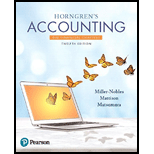
Concept explainers
Using Excel for capital budgeting calculations
Download an Excel template for this problem online in MyAccountingLab or athttp://www.pearsonhighered.com/Horngren
Glacier Creek Textiles is planning to purchase new manufacturing equipment. The equipment has an acquisition cost of $100,000, an estimated useful life of five years and no residual value. The company uses a 12%
| Year | Net |
Net |
| 0 | $(100,000) | |
| 1 | 25,000 | |
| 2 | 29,000 | |
| 3 | 26,000 | |
| 4 | 28,000 | |
| 5 | 35,000 |
Requirements
1. Compute the accounting rate of return.
2. Compute the
3. Compute the net present value of the investment using Excel's NPV function.
4. Compute the profitability index, rounded to two decimal places.
5. Compute the internal rate of
Want to see the full answer?
Check out a sample textbook solution
Chapter 26 Solutions
Horngren's Accounting, The Financial Chapters (12th Edition)
- I want to correct answer general accounting questionarrow_forwardthe estimated total fixed cost is:arrow_forwardStone Company is facing several decisions regarding investing and financing activities. Address each decision independently. On June 30, 2024, the Stone Company purchased equipment from Paper Corporation. Stone agreed to pay $28,000 on the purchase date and the balance in five annual installments of $5,000 on each June 30 beginning June 30, 2025. Assuming that an interest rate of 10% properly reflects the time value of money in this situation, at what amount should Stone value the equipment? Stone needs to accumulate sufficient funds to pay a $580,000 debt that comes due on December 31, 2029. The company will accumulate the funds by making five equal annual deposits to an account paying 5% interest compounded annually. Determine the required annual deposit if the first deposit is made on December 31, 2024. On January 1, 2024, Stone leased an office building. Terms of the lease require Stone to make 10 annual lease payments of $138,000 beginning on January 1, 2024. A 10% interest rate…arrow_forward
- 1. I want to know how to solve these 2 questions and what the answers are 1. Solar industries has a debt-to-equity ratio of 1.25. Its WACC is 7.8%, and its cost of debt is 4.7%. The corporate tax rate is 21%. a. What is the company’s cost of equity capital?b. What is the company’s unlevered cost of equity capital?c. What would be the cost of equity if the D/E ratio were 2? What if it were 1? 2. Therap software company is trying to determine its optimal capital structure. The company’s current capital structure consists of 35% debt and 65% common equity; however, the treasurer believes that the firm should use more debt. Currently, the company’s cost of equity capital is 9%, which is determined by CAPM. What would be Therap’s estimated cost of equity capital if they change their capital structure to 50% debt? Risk-free rate is 3%, market index returns 11%, and the Therap’s tax rate is 25%.arrow_forwardCompute the company's gross profit percentage for this financial accounting questionarrow_forwardWhat is the year 1 cash flow for this project on these financial accounting question?arrow_forward
- Principles of Accounting Volume 2AccountingISBN:9781947172609Author:OpenStaxPublisher:OpenStax College
 Cornerstones of Cost Management (Cornerstones Ser...AccountingISBN:9781305970663Author:Don R. Hansen, Maryanne M. MowenPublisher:Cengage Learning
Cornerstones of Cost Management (Cornerstones Ser...AccountingISBN:9781305970663Author:Don R. Hansen, Maryanne M. MowenPublisher:Cengage Learning EBK CONTEMPORARY FINANCIAL MANAGEMENTFinanceISBN:9781337514835Author:MOYERPublisher:CENGAGE LEARNING - CONSIGNMENT
EBK CONTEMPORARY FINANCIAL MANAGEMENTFinanceISBN:9781337514835Author:MOYERPublisher:CENGAGE LEARNING - CONSIGNMENT  Managerial Accounting: The Cornerstone of Busines...AccountingISBN:9781337115773Author:Maryanne M. Mowen, Don R. Hansen, Dan L. HeitgerPublisher:Cengage Learning
Managerial Accounting: The Cornerstone of Busines...AccountingISBN:9781337115773Author:Maryanne M. Mowen, Don R. Hansen, Dan L. HeitgerPublisher:Cengage Learning Managerial AccountingAccountingISBN:9781337912020Author:Carl Warren, Ph.d. Cma William B. TaylerPublisher:South-Western College Pub
Managerial AccountingAccountingISBN:9781337912020Author:Carl Warren, Ph.d. Cma William B. TaylerPublisher:South-Western College Pub Intermediate Financial Management (MindTap Course...FinanceISBN:9781337395083Author:Eugene F. Brigham, Phillip R. DavesPublisher:Cengage Learning
Intermediate Financial Management (MindTap Course...FinanceISBN:9781337395083Author:Eugene F. Brigham, Phillip R. DavesPublisher:Cengage Learning





